Are you looking for easy home gardening ideas that will bring a little bit of nature into your home? Today I’ll show you 10 easy home gardening ideas that will have you growing a green thumb in no time. You’ll be sure to find something that gets you out of the house and isn’t too hard to learn.
Gardening is a fun and rewarding hobby that can be enjoyed by anyone, regardless of their skill level or the size of their yard. There are so many ways to get started so I’m going to suggest a few easy options that might spark your interest.
Soon you will be transforming part of your home into a lush, thriving garden. Or maybe you just want a space to sit and relax. And maybe you want to grow your own food. Whatever purpose your garden serves, even just a single plant, is well worth the small price you pay and the little effort required to maintain it.
Table of Contents:
- Container Garden
- Vertical Garden
- Herb Garden
- Fairy Garden
- Raised Garden Bed
- Rock Garden
- Window Box Garden
- Cut Flower Garden
- Wildlife Garden
- Succulent Garden
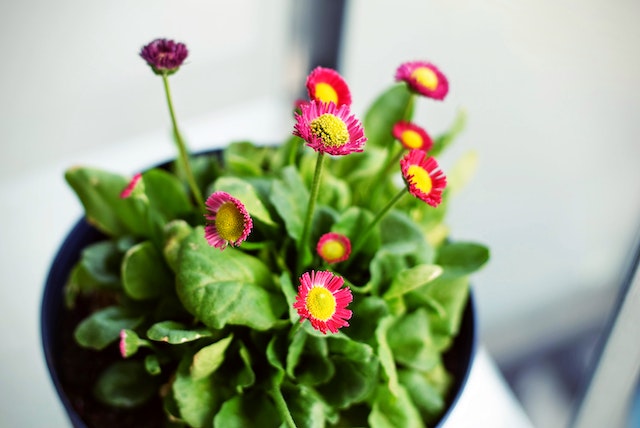
Container Garden
If you have a small space, or simply want to add a pop of color to your patio, balcony, or front steps, container gardening is a great option. There are a wide variety of plants to choose from, including herbs, flowers, and even small fruits and vegetables. Oftentimes choosing the right size and style of container is just as enjoyable as planting it.
Here are some low maintenance flowers, vegetables, and herbs you can grow in containers:
Flowers:
Petunias: These colorful and vibrant flowers are perfect for your container garden. You can grow them in pots or hanging baskets, and they come in a wide range of colors and sizes. Petunias are best planted in the spring and summer. They need full sun to partial shade and well-drained soil. Water them regularly, but avoid over-watering, as this can lead to root rot.
Marigolds: Marigolds are tough and hardy plants that are perfect for container gardens. They come in a range of bright and cheerful colors and they’re easy to care for. Marigolds are best planted in the spring and summer. They need full sun and well-drained soil. They are also drought-tolerant and don’t require much water.
Vegetables:
Tomatoes: Tomatoes are one of the most popular vegetables you can grow in containers. They are easy to manage and are great for small spaces. Tomatoes need full sun and well-drained soil. You can plant them in the spring and summer. Water them regularly, and fertilize them every two weeks with a balanced fertilizer.
Peppers: Peppers are another popular vegetable you can grow in containers. They come in a wide range of sizes and colors and are easy to grow. Peppers need full sun and well-drained soil. They are best planted in the spring and summer. Water them regularly and fertilize them every two weeks with a balanced fertilizer.
Herbs:
Basil: Basil is a fragrant and flavorful herb that is perfect for container gardens. You can grow them easily and enjoy them in many recipes. Basil needs full sun and well-drained soil. Basil is best for planting in the spring and summer. Water it regularly, but avoid over-watering, as this can lead to root rot.
Thyme: Thyme is a versatile and aromatic herb that is perfect for container gardens. It is easy to grow and is great for adding flavor to dishes. Thyme needs full sun and well-drained soil. It is best planted in the spring and summer. Water it regularly, but avoid over-watering, as this can lead to root rot.
If you have a particular interest in a plant that isn’t in this list, feel free to experiment with it. Experimenting with plants helps you learn a lot and it’s definitely part of the fun.
With the right care, you can enjoy fresh produce and beautiful plants all year round. Be aware that anything considered an annual plant will die back and not return in the next growing seasons. If a plant is considered perennial, it will return for more than one growing season.
Just remember to choose the right plants for your environment, provide them with enough sunlight, water them regularly, and fertilize them as needed.
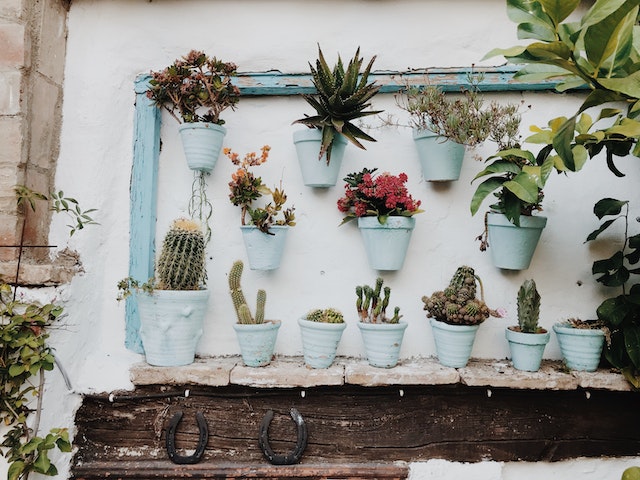
Vertical Garden
If you have limited space, consider vertical gardening. This technique is a creative and space-saving way to grow your favorite plants, flowers, and vegetables. Instead of using traditional garden beds, vertical gardening involves using wall space to grow plants upward. It’s ideal for people with limited outdoor space or for those who want to add a unique touch to their gardens.
When choosing plants for your vertical garden, consider the amount of light they need, as well as their growth habits. Some popular plants for vertical gardening include herbs, strawberries, succulents, and flowering vines.
To start a vertical garden, you’ll need a sunny wall or fence, containers, soil, and plants. You can use a variety of containers, including pots, hanging baskets, or wall-mounted planters. Fill the containers with high-quality potting soil and plant your selected plants. Water your plants regularly and make sure they receive adequate sunlight.
Aside from space saving, vertical gardens can even help improve air quality. Vertical gardens can help reduce energy costs by providing shade and insulation. And they will certainly add color and life to any outdoor space.
Vertical gardening is a great way to grow your favorite plants in a space-saving manner. With a little creativity, you can turn any wall or fence into a beautiful and productive garden. So why not start your own vertical garden today?
If you’re looking for a little inspiration, I recommend checking out these unique space saving vertical gardens.

Herb Garden
Herb gardens are the spice of life! Whether you’re a seasoned green thumb or just starting out, growing your own herbs is an easy and delicious way to add some zing to your cooking and a pop of greenery to your outdoor space.
Not only are herb gardens a fun hobby, but they also have many health benefits. Herbs are packed with antioxidants, vitamins, and minerals that can help boost your immune system and improve your overall health. Plus, growing your own herbs is a great way to know exactly what you’re putting into your food and avoid any unwanted chemicals or additives.
So, what herbs should you grow in your herb garden? Well, that depends on your personal preferences, but here are a few popular herbs that are easy to grow and perfect for beginners:
Basil: This sweet and fragrant herb is a staple in Italian cooking and can be used to make delicious pesto, caprese salad, and more.
Mint: Whether you prefer peppermint, spearmint, or another variety, mint is an easy-to-grow herb that adds a refreshing flavor to tea, cocktails, and desserts.
Rosemary: This woody herb has a strong, pungent flavor that is perfect for seasoning meats, vegetables, and soups.
Thyme: This versatile herb can be used to add flavor to a variety of dishes and is especially delicious in Mediterranean and French cuisine.
Chives: These delicate herbs have a mild onion flavor and can be used to add a touch of flavor to eggs, potatoes, and salads.
So, what are you waiting for? Grab your gardening gloves and get growing! A delicious and healthy herb garden is just a few seeds away.
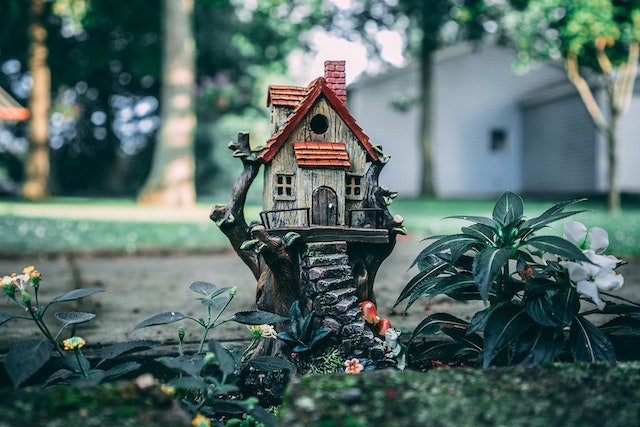
Fairy Garden
A fairy garden is a miniature garden that is designed to be a magical and enchanting place, inspired by the whimsical world of fairies. These gardens often include tiny structures, such as houses, bridges, and fences, as well as miniature plants, flowers, and other natural elements.
Fairy gardens are often used as decorative elements in homes, patios, or other outdoor spaces. They can be created in pots, planters, or even in small spaces in a traditional garden. My mom is pretty crazy about fairy gardens and I’ve certainly had fun growing them with her over the years.
Here are a few examples of fairy gardens that might inspire your creativity:
Woodland fairy garden: featuring miniature trees, mushrooms, and other elements inspired by a forest setting.
Beach-themed fairy garden: complete with tiny seashells, sand, and miniature beach huts.
Medieval fairy garden: complete with tiny castle walls, towers, and other elements inspired by the Middle Ages.
Whimsical fairy garden: filled with colorful flowers, butterflies, and other whimsical elements.
Enchanted fairy garden: featuring tiny houses and structures hidden among the plants and flowers.
Fairy gardens are a fun and creative way to bring a touch of magic and whimsy to your home or garden. Whether you prefer a simple or elaborate design, a fairy garden is sure to be a delight for the whole family.
Choosing plants for your fairy garden
When choosing plants for your fairy garden, look for small-scale plants that fit the size of your miniature garden. Here are a few popular plants that are perfect for fairy gardens:
Miniature succulents: These small, low-maintenance plants come in a variety of shapes and colors, and are perfect for creating a tiny desert landscape in your fairy garden.
Mosses: Mosses add texture and a natural look to your fairy garden, and can be used to create a soft ground cover or to add depth to your miniature landscapes.
Dwarf conifers: These small evergreen trees make great additions to your fairy garden, and can be used to create a forested or woodland scene.
Miniature roses: These tiny roses come in a variety of colors and are perfect for creating a charming rose garden in your fairy garden.
Ferns: Ferns are a great way to add greenery to your fairy garden, and their delicate leaves and soft texture create a sense of magic and enchantment.
Miniature perennials: There are many perennials that stay small in size, making them ideal for fairy gardens. Examples include lavender, thyme, and periwinkle.
Miniature bulbs: Bulbs such as crocuses, tulips, and daffodils are small in size and add a touch of spring to your fairy garden.
Remember, when creating your fairy garden, you can mix and match plants and other elements to create a unique and magical environment. Get creative and have fun!
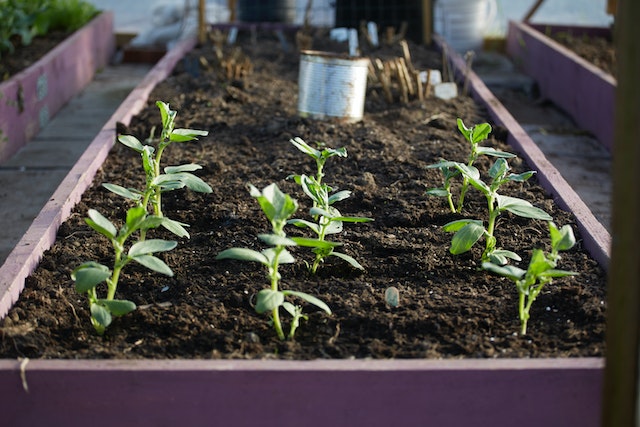
Raised Garden Bed
Building a raised garden bed is a great way to grow your own fresh vegetables and flowers, and it’s easier than you might think! Here’s a step-by-step guide to building a simple raised bed:
Choose a location
Select a sunny spot in your yard that has good drainage. The size and shape of your garden bed will depend on the space you have available. If the area you’ve chosen doesn’t have much sunlight, don’t worry – you can choose shade tolerant plants and vegetables that will work for your situation.
Measure and mark
Measure out the area you want to use for your garden bed and mark the perimeter with spray paint or stakes and string.
Prepare the site
My favorite option for prepping the site is sheet mulching.
The process of sheet mulching starts with removing any existing weeds or grass from the area to be mulched. You can also mow the grass on the lowest setting or trim it down with a weed eater. Then, a layer of cardboard or newspaper is laid down to smother any remaining vegetation and to help prevent new weeds from sprouting.
Next, layers of organic matter, such as leaves, grass clippings, straw, and compost, are added on top of the cardboard or newspaper. The layers should be moistened as they are added to help encourage decomposition and to prevent the material from blowing away.
Make sure not to use any lawn or plant trimmings that have been sprayed with chemicals if you are growing food you’re going to eat.
Finally, the mulch layer is topped with a layer of wood chips or other coarse organic material to help retain moisture and to improve the appearance of the garden. Over time, the mulch will break down and improve the soil structure and fertility.
If you’re preparing a planting bed, you can skip the mulch and fill the top layer with organic garden soil. For raised beds, you should cover with at least 12-18 inches of organic garden soil for best results. Over time the layers below will break down and enhance the overall quality of your soil.
Sheet mulching is an easy and effective way to create a low-maintenance, organic garden bed, and can be used in a variety of settings, from vegetable gardens to flower beds.
Cut and attach the lumber
Cut your lumber to the desired length for the sides of the garden bed. Then, use screws or nails to attach the pieces of lumber together to form a rectangle.
The best type of lumber for raised garden beds depends on several factors, including your budget, personal preference, and the climate where you live. Here are some popular lumber options:
Cedar: a popular choice for raised garden beds because it is naturally resistant to rot and insect damage. It is also an attractive wood that can add a natural look to your garden.
Redwood: another popular option for raised garden beds. Like cedar, it is naturally resistant to rot and insect damage, and it is also durable and long-lasting.
Treated Pine: an affordable option for raised garden beds, and it is treated with chemicals to resist rot and insect damage. However, some people are concerned about the safety of using treated lumber in the garden due to the chemicals used in the treatment process.
Composite materials: materials such as recycled plastic and wood fiber, are also popular for raised garden beds. These materials are low-maintenance, long-lasting, and rot-resistant, but they can be more expensive than wood.
Ultimately, the best type of lumber for your raised garden bed will depend on your specific needs and preferences. If you have concerns about the use of treated lumber, you may want to opt for a natural wood like cedar or redwood, or consider using metal, stone, or composite materials.
Fill with soil
The best type of soil for raised garden beds is a well-draining, fertile soil mix that is rich in organic matter. A good soil mix should consist of:
Compost: Compost provides essential nutrients and organic matter to your soil, improving its structure and fertility.
Peat Moss: Peat moss helps to improve the soil’s water-holding capacity and aeration.
Vermiculite or Perlite: These materials help to improve soil drainage and aeration, ensuring that your plants receive adequate oxygen.
Topsoil: Topsoil provides a base for your soil mix and can be used to help adjust the soil pH if necessary.
When filling your raised garden bed with soil, aim for a depth of at least 12-18 inches to provide enough room for the roots of your plants to grow. You can mix the ingredients together in a wheelbarrow or other large container, or purchase pre-made soil blends from a garden center or online.
It’s important to note that the quality of the soil in your raised garden bed can decline over time, so it may be necessary to amend it periodically with compost or other organic matter to maintain its fertility and structure.
Add plants or seeds
Choosing between seeds and plants for your raised garden bed can be a difficult decision, but both options have their benefits and drawbacks. Here are a few factors to consider when making your choice:
Timing: If you’re planting in early spring, starting with plants may be the faster option since seeds may take several weeks to germinate and grow. However, if you have more time, starting with seeds can be a cost-effective option.
Space: If you have limited space in your raised garden bed, starting with plants may be the best choice since they take up less room. However, if you have a larger bed, you may prefer to start with seeds to maximize your growing area.
Skill level: If you’re new to gardening, starting with plants may be easier, as they have already been started for you. However, if you’re more experienced and feel confident in your ability to start seeds, this option can give you a wider variety of plants to choose from.
Variety: Starting with seeds can give you access to a much wider variety of plants, including heirloom and specialty varieties that may not be available as plants.
Cost: Starting with plants can be more expensive upfront, but starting with seeds can be a cost-effective option in the long run, especially if you plan to save your own seeds for future seasons.
Ultimately, the best choice for your raised garden bed will depend on your specific needs and preferences. Whether you choose seeds or plants, be sure to research the plants you want to grow and provide them with the proper care, including adequate sunlight, water, and nutrients, to help them thrive.
Water and maintain
Water your garden regularly and make sure to keep an eye out for any weeds or other pests. You may also want to add mulch, straw, or other organic matter to the top of the soil to help retain moisture.
That’s it! Building a raised garden bed is a fun and rewarding project that can be done in a few hours. Start today and enjoy fresh, homegrown produce in no time!
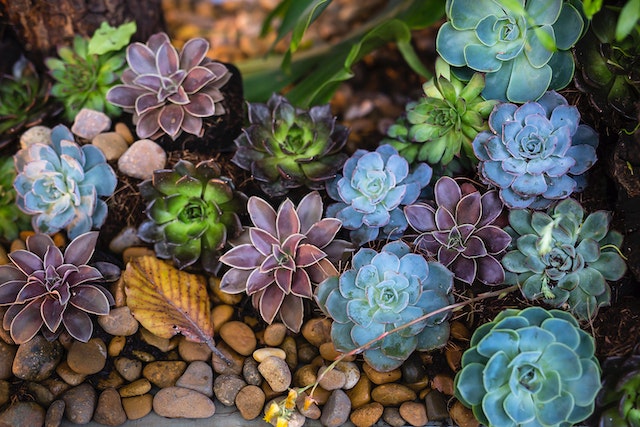
Rock Garden
A rock garden typically features rock formations, such as stones and boulders, as the main focus. These gardens often include small, low-growing plants and flowers that are adapted to grow in rocky, well-drained soils.
The goal of a rock garden is to create a naturalistic and scenic landscape that resembles a mountain or alpine environment. Rock gardens can be designed in a variety of styles, from traditional Japanese zen rock gardens to more elaborate rock formations that incorporate water features, such as waterfalls and streams. They are a low-maintenance and unique way to add visual interest to your outdoor space.
Here are a few plants that are well-suited for rock gardens:
Sedum: This succulent plant is low-growing and comes in a variety of colors, making it a popular choice for rock gardens.
Sempervivum: Also known as hen and chicks, this rosette-forming succulent is drought-tolerant and adapts well to rocky soils.
Thyme: Thyme is a fragrant herb that is often used in cooking, and it can also make a great groundcover for rock gardens with its low-growing habit.
Alpine Phlox: This small, colorful flowering plant is a popular choice for rock gardens due to its adaptability to rocky soils and ability to produce vibrant blooms in spring and summer.
Rock Cress: Rock cress is an evergreen plant that produces delicate, fragrant flowers in spring. It grows well in rocky soils and is often used as a groundcover in rock gardens.
Saxifraga: This small, flowering plant is prized for its ability to grow well in rocky soils and produce delicate, star-shaped blooms in spring and summer.
These are just a few examples of the many plants that can be used in rock gardens. When selecting plants for your rock garden, it’s important to consider their light, water, and soil requirements, as well as their size and growing habits. This will help ensure that you choose plants that will thrive in your particular rock garden environment.
For a little inspiration, check out these 30 interesting rock garden examples.

Window Box Garden
Window box gardens are small, decorative gardens that are designed to be placed on windowsills or hung on a window. These gardens typically feature a variety of small plants, flowers, and herbs grown in a container, such as a wooden box, that can be easily mounted on a window.
Window boxes are a great way to bring a touch of greenery and color to your home, and they are a simple and low-maintenance way to start gardening. You can easily design them to suit your personal style and preferences, and they can range from simple and minimalist to elaborate and colorful.
Choose plants that are well-suited to your growing conditions, such as those that prefer bright or partial shade, and you can arrange them in a variety of patterns or styles to create a visually appealing display.
Whether you’re a seasoned gardener or a beginner, window box gardens are a fun and creative way to get involved in gardening and enjoy the benefits of growing your own plants.
Here are a few plants that are well-suited to window box gardens:
Petunias: These bright and colorful flowering plants are a popular choice for window boxes due to their long blooming period and ease of care.
Marigolds: Marigolds are another colorful flowering option for window boxes. They are easy to grow and care for and are available in a range of vibrant colors.
Pansies: Pansies are a popular choice for window boxes because of their cheerful blooms and ability to bloom in cool weather.
Herbs: Herbs such as basil, mint, thyme, and parsley are great options for window boxes. Not only do they add a touch of greenery to your windowsill, but you can also harvest them to use in your cooking.
Ivy: Ivy is a trailing plant that can be grown in a window box. It is a hardy plant that is easy to care for and adds a touch of green to your windowsill.
Ferns: Ferns are another trailing option for window boxes. They are low-maintenance and thrive in shady locations, making them a great choice for window boxes that receive little direct sunlight.
These are just a few examples of plants that you can grow in window boxes. It’s common to change out window boxes with the seasons for varying levels of color and year round interest. Don’t hesitate to experiment. Window boxes are a great way to experiment with style and creativity.
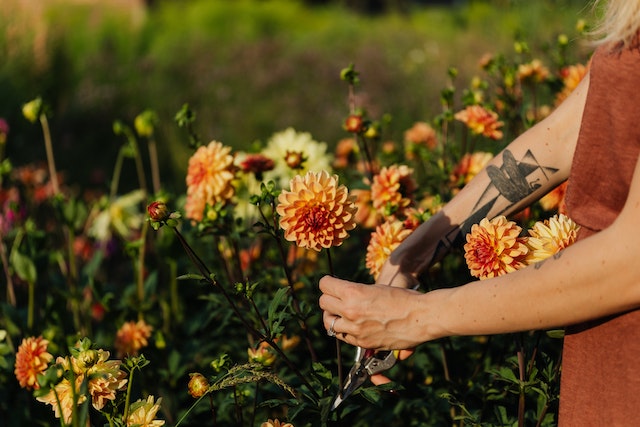
Cut Flower Garden
Growing a cut flower garden can be a fun and rewarding experience. Whether you’re growing flowers for your own enjoyment or for selling at a farmers market, a cut flower garden can provide you with a bounty of beautiful blooms throughout the growing season. Here are the steps to get started:
Choose a location: Pick a sunny spot in your yard with well-drained soil for your cut flower garden. This will provide the best growing conditions for your flowers.
Plan your garden: Decide on the types of flowers you want to grow and arrange them in a layout that will maximize the use of space. Consider the height, color, and blooming time of each flower to create an attractive and harmonious garden.
Prepare the soil: Loosen the soil in your garden bed and amend it with compost to improve its fertility. This will provide your plants with the nutrients they need to thrive.
Choose your plants: Select plants that are well-suited to your growing conditions, such as sun-loving or shade-tolerant varieties. Purchase healthy plants from a reputable nursery or start your own from seeds.
Plant your flowers: Plant your flowers at the appropriate depth and spacing, following the instructions on the seed packets or plant labels. Water your plants well after planting and mulch the soil to retain moisture and suppress weeds.
Care for your flowers: Regularly water your flowers, fertilize them with a balanced fertilizer, and remove any spent blooms to encourage new growth. Prune your plants as needed to maintain their shape and promote bushier growth.
Harvest your flowers: As your flowers begin to bloom, you can start cutting them for use in arrangements. Cut your flowers early in the morning, when the flowers are full of water, and place them in water immediately to help extend their vase life.
Popular flowers to consider for a cut flower garden
Zinnias: These bright and cheerful flowers are easy to grow from seed and come in a range of colors, making them a great choice for cut flower arrangements.
Sunflowers: Sunflowers are a classic choice for cut flower gardens and are available in a range of sizes and colors.
Cosmos: These delicate, daisy-like flowers come in a range of colors, including pink, white, and orange, and are easy to grow from seed.
Dahlias: Dahlias are a classic summer flower that come in a range of colors, shapes, and sizes.
Sweet Peas: Sweet peas are a classic cottage garden flower that have a sweet fragrance and come in a range of colors.
Larkspur: Larkspur are tall, spiky flowers that come in shades of blue, pink, and purple and are easy to grow from seed.
Lilacs: Lilacs are a fragrant spring flower that come in shades of pink, purple, and white.
Seed packets to consider for your cut flower garden
Baker Creek Heirloom Seeds: Baker Creek offers a wide range of heirloom flower seeds that are well-suited for cut flower gardens.
Johnny’s Selected Seeds: Johnny’s Selected Seeds offers a range of high-quality seeds for cut flowers, including sunflowers, zinnias, and dahlias.
Seed Savers Exchange: This non-profit organization offers a range of heirloom and open-pollinated flower seeds, including many that are well-suited for cut flower gardens.
Burpee Seeds: Burpee Seeds offers a wide range of flower seeds, including sunflowers, zinnias, and cosmos, that are well-suited for cut flower gardens.
By choosing the right flowers and seeds, you can grow a beautiful and bountiful cut flower garden that will provide you with an abundance of blooms to enjoy and share.
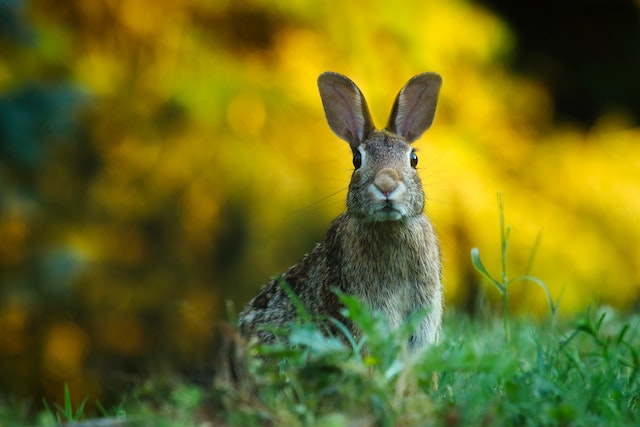
Wildlife Garden
Wildlife gardening focuses on creating a habitat for local wildlife. This is achieved by planting native species of plants, and creating nesting sites for birds, insects, and other beneficial wildlife. The main aim of wildlife gardening is to provide a safe and comfortable environment for local animals and to promote biodiversity.
In addition to providing a habitat for wildlife, there are several benefits for humans. For example, gardening for wildlife can increase the number of pollinators in your garden, which can lead to a more productive fruit and vegetable garden. Wildlife gardening can also help to reduce the amount of garden maintenance required, as birds, beneficial insects, and other wildlife will help to control harmful pests.
When starting a wildlife garden, it’s important to choose plants that are native to your area and to consider the needs of the wildlife you want to attract. For example, if you want to attract birds, you should plant shrubs and trees that provide food and shelter, such as berry bushes and bird boxes. If you want to attract butterflies, you should plant nectar-rich flowers, host plants for nesting and egg laying, as well as a source of water for them to drink from.
Popular Plants To Consider For Your Wildlife Garden
- Milkweed (Asclepias species) – Attracts butterflies, especially monarchs, and serves as their primary food source.
- Goldenrod (Solidago species) – Provides nectar for adult butterflies and a food source for caterpillars.
- Joe-Pye weed (Eupatorium species) – Attracts many species of butterflies and also provides food for some species of birds.
- Black-eyed Susan (Rudbeckia hirta) – Provides nectar for butterflies, bees, and other pollinators, and also serves as a food source for birds.
- Dogwood (Cornus species) – Provides food for birds and wildlife, and also serves as a nesting site for birds.
- Serviceberry (Amelanchier species) – Provides food for birds and wildlife, and also serves as a nesting site for birds.
- New England aster (Symphyotrichum novae-angliae) – Provides nectar for adult butterflies and a food source for caterpillars.
- Wild bergamot (Monarda fistulosa) – Provides nectar for many species of bees and butterflies and also serves as a food source for some species of birds.
- Ironweed (Vernonia species) – Provides nectar for adult butterflies and a food source for caterpillars.
- Swamp milkweed (Asclepias incarnata) – Attracts butterflies and also serves as a food source for some species of birds.
These are just a few examples of the many native plants that are great for wildlife gardening. When selecting plants for your wildlife garden, it is important to choose species that are native to your area and to consider the needs of the wildlife you want to attract.
In addition to planting, there are several other ways to encourage wildlife into your garden. You can install bird feeders, baths, houses, and you can also create a pond or water feature to provide a source of water for wildlife.
If done correctly, wildlife gardening is a wonderful way to create a habitat for local wildlife, while also enjoying the benefits of a more diverse and productive garden. With the right plants, a little planning and some basic wildlife-friendly features, you can help to protect local wildlife and support biodiversity.
Here are 25 wildlife garden ideas you can use as inspiration to transform your home garden into a nature friendly space.
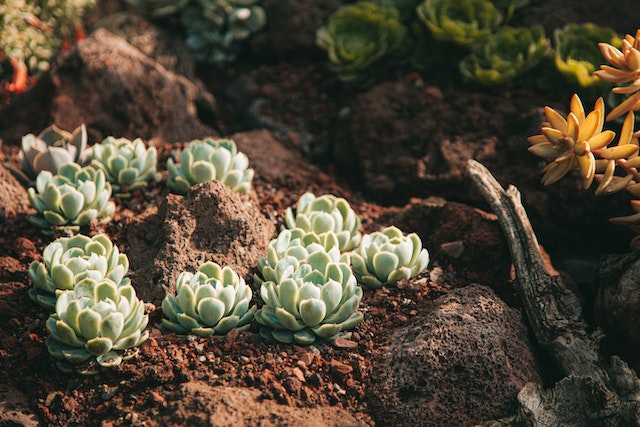
Succulent Garden
Succulents are easy-to-care-for plants that make great additions to any home garden. Succulents can even be planted in areas that are hard to grow other plants due to their ability to adapt to harsh and dry situations.
Here’s a guide on creating your own succulent garden:
Keep in mind this guide discusses growing succulents in a container, however, you can plant succulents directly in the ground. I’ve planted elaborate succulent “desert” gardens that fill whole yards. The same steps apply to both situations.
Choose your container: Select a container that has good drainage holes, as succulents do not like to sit in standing water. Terra cotta pots, wooden boxes, or any other decorative containers can be used.
Add a layer of stones or gravel: Add a layer of stones or gravel to the bottom of your container to improve drainage and prevent water from pooling at the bottom.
Add a layer of soil: Fill the container with a well-draining potting soil. Succulents do not like heavy, dense soil and need good air flow around their roots. If it’s hard to find well-draining soil, especially to cover larger areas, you can mix with sand, peat moss, or other fast draining matter.
Choose your plants: There are many types of succulents to choose from, including Aloe Vera, Sedum, Echeveria, and many others. Consider the size and light requirements of each plant and select a variety that will fit well in your container.
Plant your succulents: Carefully remove the plants from their pots and plant them into the soil in your container, spacing them evenly apart. Gently press down on the soil to secure the plants in place without compacting the soil and root system.
Water your plants: Water your succulents sparingly, as they do not require frequent watering. Allow the soil to dry out completely between waterings.
Place your succulent garden in a location with bright, indirect light. Avoid direct sunlight, which can cause your plants to become sunburned. If you’re planting your succulents directly in the ground, they will be able to grow more substantial root systems and won’t be harmed by direct sunlight.
By following these steps, you can create a beautiful and thriving succulent garden that will add a touch of greenery to your home. With their easy care requirements and attractive appearance, succulents are a great choice for anyone looking to start a home garden.
I couldn’t end this post without a little inspiration. Check out these 30 succulent garden ideas for your outdoor oasis.
If you have any questions or comments regarding these 10 easy home gardening ideas just comment below and I’ll check it out. I review all comments myself and always appreciate your feedback. Happy gardening!

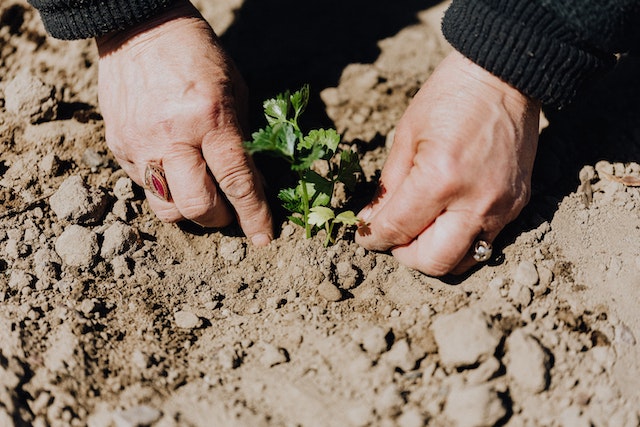
Wow! Great information!
Thanks! You got a mention in the fairy garden section 🙂
You are a wealth of valuable information. I appreciate how you have broken down tings into categories and added links within you post. I didn’t notice, but is there a way to sign up to get your post regularly? I might be contacting you in the future for a walk-through in our yard. I’m at a place where I’m not sure where to go from here with landscaping and gardening. I put in a kitchen garden last year I would like to add fruit trees within the landscape, but I think there’s a lot of work that Hass to be done first. Very happy to have found you.
Thank you Marie! The site is brand new and I’m working on putting together a newsletter that will include the latest posts. I’ll be sure to let you know when it’s available.
I would love to stop by for a walkthrough at your property and discuss your ideas and goals. You can set that up through my contact page when you’re ready. A kitchen garden with fruit trees sounds lovely.
I’m happy you found me as well. Looking forward to chatting more soon!